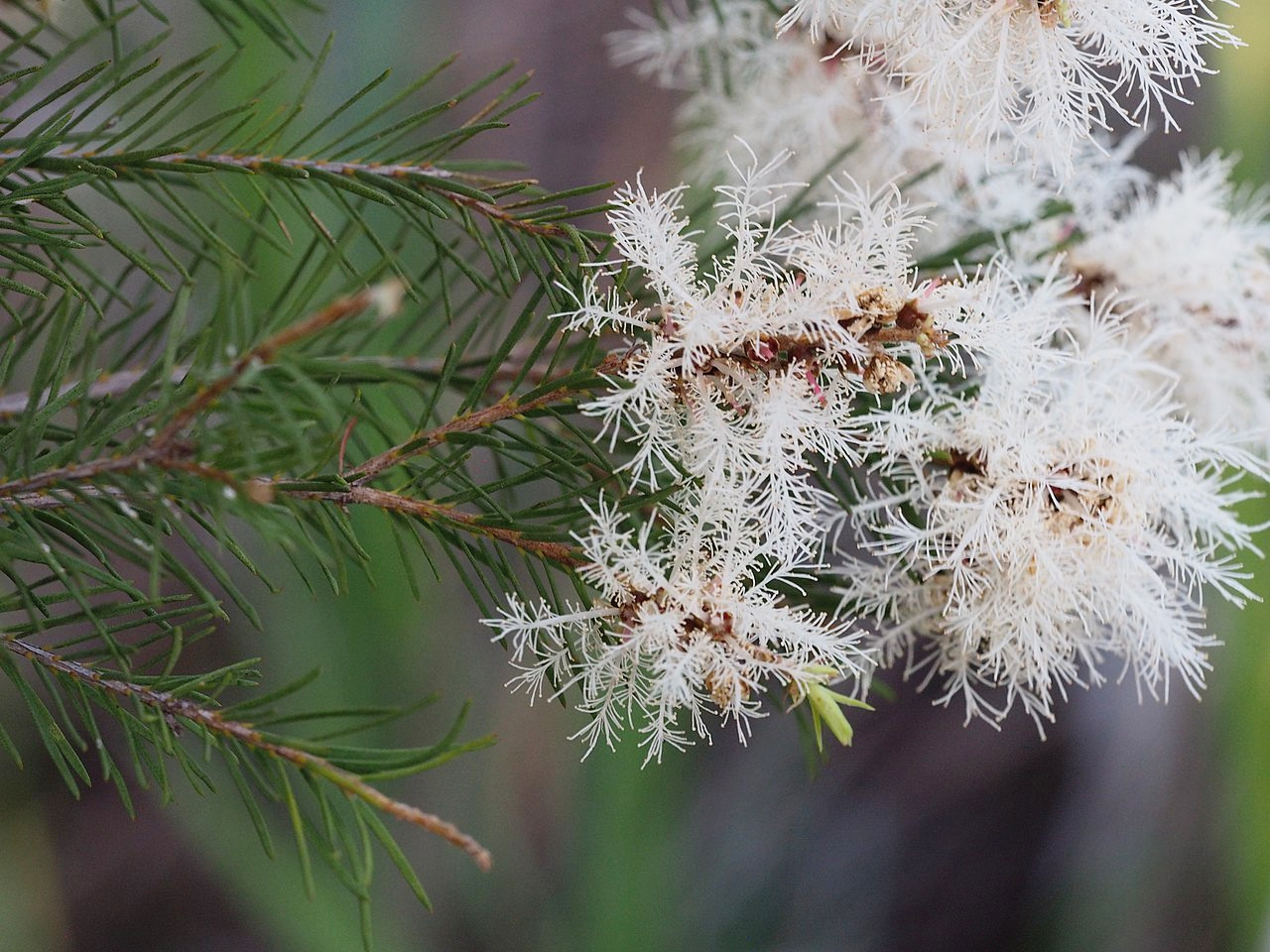Melaleuca alternifolia (Maiden & Betche) Cheel - Myrtaceae - (narrow-leaf) tea tree, narrow-leaf paperbark, Teebaum
Tall shrub or small tree, up to 7m high, native to New South Wales; bark papery; leaves irregularly arranged, scattered to whorled, linear, up to 3.5cm long; inflorescence a many-flowered spike, up to 5cm long, resembling bottle-brushes; flowers solitary within each bract, white, petals broad-elliptic, 2-3mm long; fruit cup-shaped, 2-3mm diam. http://plantnet.rbgsyd.nsw.gov.au/cgi-bin/NSWfl.pl?page=nswfl&lvl=sp&name=Melaleuca~alternifolia
„Melaleuca alternifolia is a medium sized tree that occurs naturally in a very limited area of Australia, on the north coast of New South Wales (NSW) where it is restricted to the narrow plain between the coast and the
dividing range. The tree occurs mainly in wetter areas and swamps, generally in fairly dense stands that often contain relatively few other species… Most producers take their first harvest 12 months after planting
and, thereafter, on an annual basis. From the second harvest onwards, the industry oil yield averages about
150kg per hectare per annum for planting densities of 25,000 - 35,000 per ha. Yields can vary considerably from
less than 100kgs per hectare to over 500kg per hectare, though both these extremes are unusual. “
http://www.nononsensecosmethic.org/wp-content/uploads/2014/04/Australian-tea-tree-industry-R-Davis.pdf
„The indigenous Bundjalung people of eastern Australia use „tea trees“ as a traditional medicine by inhaling the oils from the crushed leaves to treat coughs and colds. They also sprinkle leaves on wounds, after which a poultice is applied. In addition, tea tree leaves are soaked to make an infusion to treat sore throats or skin ailments.“
http://en.wikipedia.org/wiki/Melaleuca_alternifolia
„As indicated by the title of the ISO standard, tea tree oil is rich in terpinen-4-ol, typically in the range of 35-42%. 1:8-cineole has also been noted as an important constituent, even though it rarely exceeds 5% in commercial oil. In the early days, 1:8-cineole was noted in order to distinguish the various chemotypes of tea tree oil available: low cineole (2-10%), high cineole (20-40%) and very high cineole (60%+). During the 1980s boom time, however, the cineole content of tea tree oil became an indicator of quality - the lower the better. Various reasons were given as to why cineole was supposedly detrimental to the oil, such as it being a skin irritant. This was despite much published information that cineole was not a skin irritant, including one report that named nearly all the components of tea tree oil other than cineole as being potential skin irritants. Slowly, the industry realised that terpinen-4-ol was the main indicator of antimicrobial activity, or at least up to levels of 40%. Interestingly, none of the individual components of tea tree oil, including
terpinen-4-ol, are as widely active as the whole oil.“
A typical gas chromatographic profile for Australian tea tree oil shows as components: α-pinene (1-6%), sabinene (trace-3.5%), α-terpinene (5-13%), limonene (0.5-4%), ρ-cymene (0.5-8%), 1,8-cineole (0-15%), γ-terpinene (10-28%), terpinolene (1.5-5%), terpinen-4-ol (30-48%), α-terpineol (1.5-8%), aromadendrene (trace-3%), ledene (trace-3%), δ-cadinene (trace-3%), globulol (trace-1%), viridiflorol (trace-1%).
[The Australian tea tree oil industry., Davis, R.L., In Proceedings of International Federation of Essential Oils and Aroma Trades International Conference ‘Australia and New Zealand: Essential Oils and
Aroma Chemicals - Production and Markets’, Sydney, 2003, 29–40] http://www.nononsensecosmethic.org/wp-content/uploads/2014/04/Australian-tea-tree-industry-R-Davis.pdf
The essential oil (Melaleucae aetheroleum), obtained from the leaves by steam distillation, is widely used in ointments and creams to treat insect bites,wounds, abrasions, acne, skin infections, fungal infections (including athlete's foot and trush). „The monoterpenes interact with biomembranes and mebrane proteins, tus explaining the observed antibacterial, antifungal and antiviral acivities. A few clinical studies have shown positive results in the treatment of acne and fungal infections.“
[Medicinal Plants of the World. Ben-Erik Van Wyk and Michael Wink, Pretoria 2004, 202]
„The mechanism of action of TTO [tea tree oil] against bacteria has now been partly elucidated… In summary, the loss of intracellular material, inability to maintain homeostasis, and inhibition of respiration after treatment with TTO and/or components are consistent with a mechanism of action involving the loss of membrane integrity and function.“
[Melaleuca alternifolia (tea tree) oil: a review of antimicrobial and other medicinal properties., Carson, C.F., Hammer, K.A., Riley, T.V., Clinical microbiology reviews, 19(1), 2006, 50-62] http://cmr.asm.org/content/19/1/50.full
There are around 100 volatile compounds present in TTO, with different chemotypes have different chemical compositions. Terpinen-4-ol is the major component (30-48%), followed by γ-terpinene (10–28%) and α-terpinene (5–13%), 1,8-cineole (0–15%), α-terpinolene (1.5–5%), α-terpineol (1.5–8%), α-pinene (1–6%), p-cymene (0.5–8%), limonene (0.5-1.5%).
 some TTO monoterpenes
some TTO monoterpenes
(left to right:) terpinen-4-ol, α-terpinene, γ-terpinene, α-terpineol, α-terpinolene
„The composition of Tea Tree Oil changes particularly in the presence of atmospheric oxygen but also when the oil is exposed to light and higher temperatures. The levels of α-terpinene, γ-terpinene and terpinolene decrease whereas the level of p-cymene increases up to tenfold. Oxidation processes lead to the formation of
peroxides, endoperoxides (ascaridole) and epoxides…
Tea Tree Oil is a skin sensitiser. Skin sensitisation may also be enhanced by irritancy. Neat
Tea Tree Oil and certain formulations at concentrations of 5% or more can induce skin and eye irritation. Based on clinical data, the current use levels of TTO are shown to induce contact allergy…
The following types of application for cosmetic products are given in the dossier: Skin - care products incl. post-waxing treatments up to 1.25%, Hair - care products up to 2.0%, Nail - care products up to 20%, Oral hygiene up to 0.2%, Personal hygiene including shaving products up to 2%. The undiluted might be used for other
purposes as well i.e. aromatherapy.“
[SCCP/1155/08 Scientific Committee on Consumer Products SCCP OPINION ON Tea tree oil- European Union Commission Health and Consumer Union protection director general- adopted 18th plenary of 16 December 2008] http://ec.europa.eu/health/ph_risk/committees/04_sccp/docs/sccp_o_160.pdf

Flowers and foliage of Melaleuca alternifolia
CC BY-SA 4.0, Author: Geoff Derrin Wikimedia Commons
